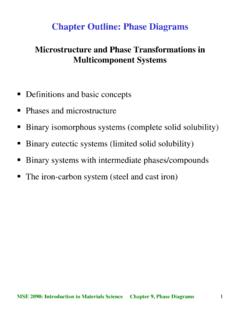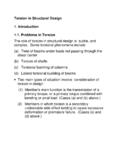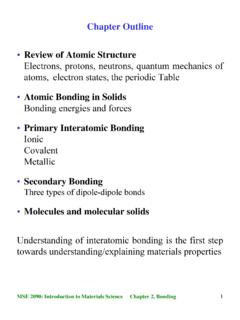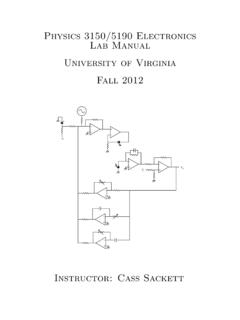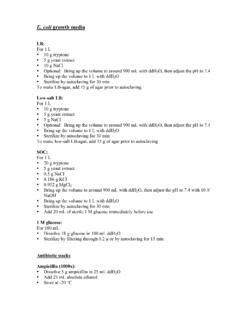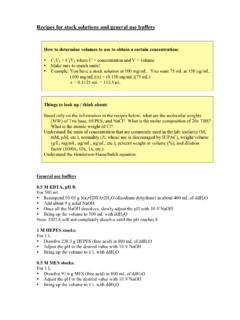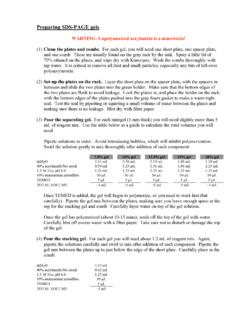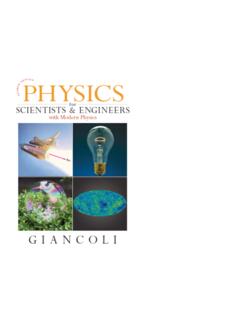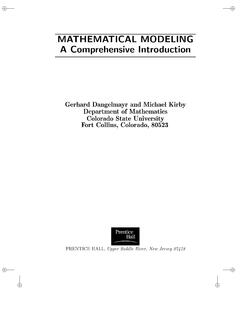Transcription of MSE 209: Introduction to the Science and Engineering of ...
1 MSE 2090: Introduction to Materials ScienceChapter 1, Introduction1 Spring 2010 MSE 209 - Section 1 Instructor: Leonid ZhigileiMonday and Wednesday, 08:30 9:45 amOlsson Hall 009 MSE 209: Introduction to the Science and Engineering of MaterialsMSE 2090: Introduction to Materials ScienceChapter 1, Introduction2 MSE 2090: Introduction to Materials ScienceChapter 1, Introduction3 Research in Computational Materials Group: simulation of impact resistance of carbon nanotube materialsTemperature distribution in a simulation of heat transfer in a carbon nanotube materialGeneration of crystal defects and melting in a metal target irradiated by a short laser pulseGroup Web Site: 2090: Introduction to Materials ScienceChapter 1, Introduction4 Instructor: Leonid ZhigileiOffice: Wilsdorf Hall, Room 303D Office Hours: 10:00 am to 12:00 pm Tuesday & openTelephone: (434) 243 3582E-mail: web page: ~lz2n/mse209/Class e-mail list: Information:Graduate Teaching Assistant:Ms.
2 Priya GhatwaiOffice: Materials Science Building 109 Office hours:4-5 pm on Tuesdays and Wednesdaysin Materials Science Building, Room 125 AYou can also e-mail Ms. Ghatwai for additional appointments and individual : 2090: Introduction to Materials ScienceChapter 1, Introduction5 Homework: 15 % Two mid-term exams: 40 % Final exam: 45 %Homework: 11 problem sets will be will be assigned and will be due at the beginning of class one week after assignment. Homework solutions should be neat and stapled. Homework does not require the pledge and cooperation among students is permitted. Copying is not homework is not acceptedTests: pledged, closed-book and closed-notesGrading:W.
3 D. Callister & D. G. Rethwisch, Materials Science and Engineering : An Introduction (John Wiley 2010, 8thedition)I will also post my lecture notes on the :MSE 2090: Introduction to Materials ScienceChapter 1, Introduction6 From atoms to microstructure: Interatomic bonding, structure of crystals, crystal defects, non-crystalline materials. Mass transfer and atomic mixing: Diffusion, kinetics of phase transformations. Mechanical properties, elastic and plastic deformation, dislocations and strengthening mechanisms, materials failure. Phase diagrams: Maps of equilibrium phases. Polymer structures, properties and applications of polymers.
4 Electrical, thermal, magnetic, and optical properties of :MSE 2090: Introduction to Materials ScienceChapter 1, Introduction7 Historical PerspectiveStone Bronze Iron Advanced materials What is Materials Science and Engineering ?Processing Structure Properties Performance Classification of MaterialsMetals, Ceramics, Polymers, Semiconductors Advanced MaterialsElectronic materials, superconductors, etc. Modern Material's Needs, Material of FutureBiodegradable materials, Nanomaterials, Smart materialsChapter 1: IntroductionMSE 2090: Introduction to Materials ScienceChapter 1, Introduction8 Beginning of the Material Science - People began to make tools from stone Start of the Stone Age about two million years ago.
5 Natural materials: stone, wood, clay, skins, etc. The Stone Age ended about 5000 years ago with Introduction of Bronze in the Far East. Bronze is an alloy(a metal made up of more than one element), copper + < 25% of tin + other : can be hammered or cast into a variety of shapes, can be made harder by alloying, corrode only slowly after a surface oxide film forms. The Iron Age began about 3000 years ago and continues today. Use of iron and steel, a stronger and cheaper material changed drastically daily life of a common person. Age of Advanced materials: throughout the Iron Age many new types of materials have been introduced (ceramic, semiconductors, polymers, ).
6 Understanding of therelationship among structure, properties, processing, and performance of design of new PerspectiveMSE 2090: Introduction to Materials ScienceChapter 1, Introduction9A better understanding of structure-composition-properties relations has lead to a remarkable progress in properties of materials. Example is the dramatic progress in the strength to density ratio of materials, that resulted in a wide variety of new products, from dental materials to tennis from: M. A. White, Properties of Materials (Oxford University Press, 1999)MSE 2090: Introduction to Materials ScienceChapter 1, Introduction10 Material Science is the investigation of the relationship among processing, structure, properties, and performance of is Materials Science and Engineering ?
7 ProcessingPropertiesStructureObservation alMaterialsOptimization LoopMSE 2090: Introduction to Materials ScienceChapter 1, Introduction11 Subatomic level (Chapter 2)Electronic structure of individual atoms that defines interaction among atoms (interatomic bonding). Atomic level (Chapters 2 & 3)Arrangement of atoms in materials (for the same atoms can have different properties, two forms of carbon: graphite and diamond) Microscopic structure (Ch. 4)Arrangement of small grains of material that can be identified by microscopy. Macroscopic structureStructural elements that may be viewed with the naked butterfly~ mMSE 2090: Introduction to Materials ScienceChapter 1, Introduction12 Length-scalesAngstrom= 1 = 1/10,000,000,000 meter = 10-10mNanometer= 10 nm = 1/1,000,000,000 meter = 10-9mMicrometer= 1 m = 1/1,000,000 meter = 10-6mMillimeter= 1mm = 1/1,000 meter = 10-3mInteratomic distance ~ a few A human hair is ~ 50 mElongated bumps that make up the data track on a CD are ~ m wide, minimum m long, and 125 nm highMSE 2090.
8 Introduction to Materials ScienceChapter 1, Introduction13 Progress in atomic-level understandingDNA~2 nm wideThings NaturalThings ManmadeThe Scale of Things (DOE)10 nmCell membraneATP synthaseSchematic, central coreCat~ mDust mite300 mMonarch butterfly~ mMEMS (MicroElectroMechanical Systems) Devices10 -100 m wideRed blood cellsPollen grainFly ash~ 10-20 m Bee~ 15 mmAtoms of siliconspacing ~tenths of nmHead of a pin1-2 mmMagnetic domains garnet film11 m wide stripesQuantum corral of 48 iron atoms on copper surfacepositioned one at a time with an STM tipCorral diameter 14 nmProgress in miniaturizationIndium arsenidequantum dot Quantum dot array --germanium dots on siliconMicroelectronicsObjects fashioned frommetals, ceramics, glasses, polymers.
9 Human hair~ 50 m wideBiomotor using ATPThe nm1 nanometer (nm) m10 m100 nm1 micrometer ( m) mm10 mm100 m1 millimeter (mm) m1 cm10 m100 mm1 meter (m)100m10-1m10-2m10-3m10-4m10-5m10-6m10- 7m10-8m10-9m10-10mVisiblespectrumThe NanoworldSelf-assembled mushroom The 21st century challenge -- Fashion materials at the nanoscale with desired properties and functionalityRed blood cellswith white cell~ 2-5 mmeterm1001 from 2090: Introduction to Materials ScienceChapter 1, Introduction14 Length and Time Scales in Materials Modelingby Greg Odegard, NASAMSE 2090: Introduction to Materials ScienceChapter 1, Introduction15 Length and Time Scales in Materials ModelingMesoscopic10-910-810-7 Length Scale, meters Scale, number of atoms 102710-1210-910-7 Time Scale, seconds 1 MicroscopicMo Li, JHU, Atomistic model of a nanocrystalline Dislocation Dynamics Nature, 12 February, 1998 Farid Abraham, IBMMD of crack propagation NanoscopicLeonid Zhigilei, UVAP hase transformation on diamond surfaces Elizabeth Holm, SandiaIntergranularfractureMonte Carlo Potts modelMSE 2090.
10 Introduction to Materials ScienceChapter 1, Introduction16 Types of MaterialsLet us classify materials according to the way the atoms are bound together (Chapter 2).Metals:valence electrons are detached from atoms, and spread in an 'electron sea' that "glues" the ions together. Strong, ductile, conduct electricity and heat well, are shiny if :the bonding is covalent(electrons are shared between atoms). Their electrical properties depend strongly on minute proportions of contaminants. Examples: Si, Ge, :atoms behave like either positive or negative ions, and are bound by Coulomb forces.
